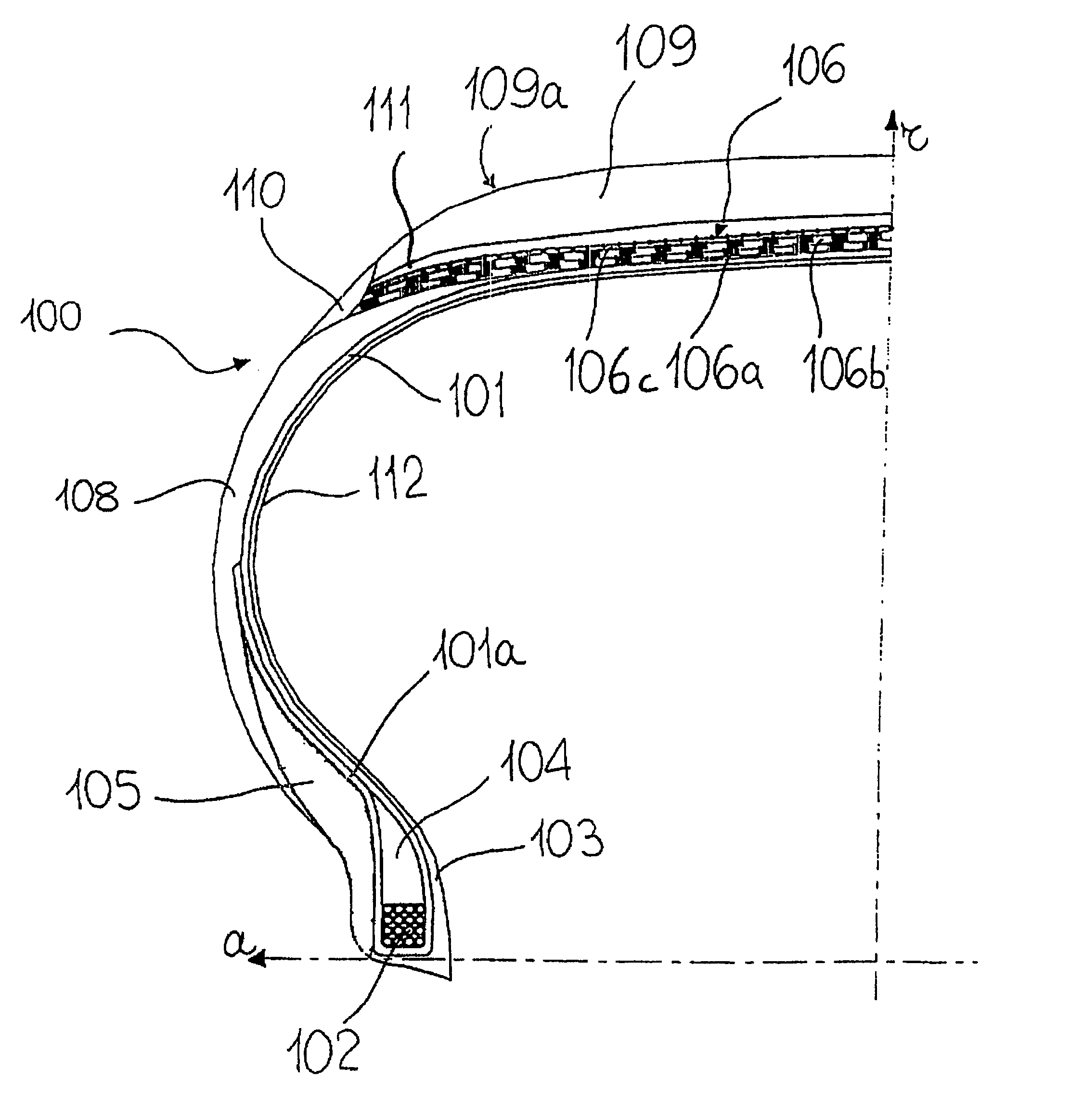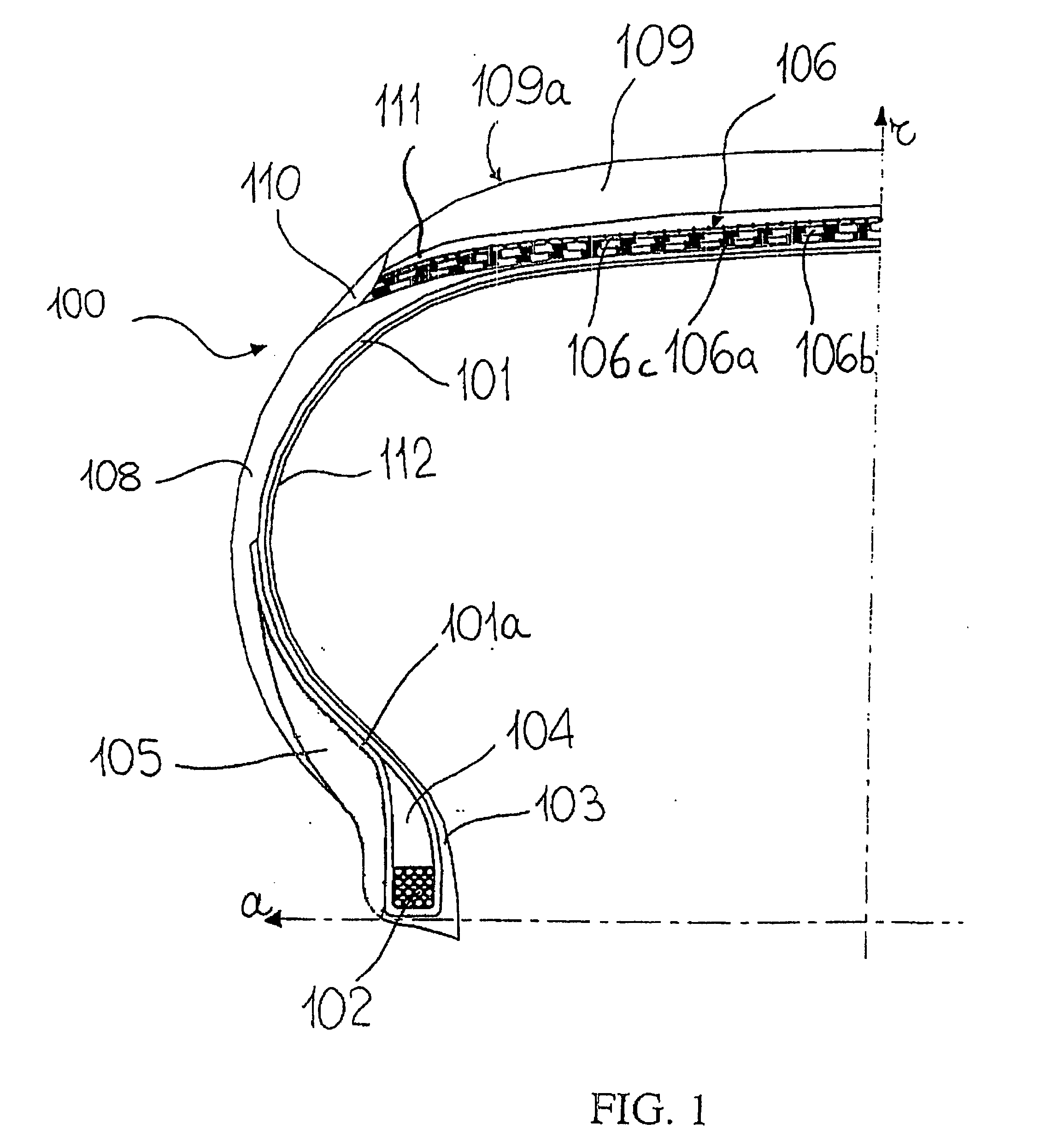Tire and Crosslinkable Elastomeric Composition
a technology of elastomeric composition and tire, which is applied in the direction of inflatable tyres, special tyres, transportation and packaging, etc., can solve the problems of increasing the degree of shrinkage, difficult to adhere butyl rubber to natural rubber or styrene/butadiene rubber, and tire structure may be damaged
- Summary
- Abstract
- Description
- Claims
- Application Information
AI Technical Summary
Benefits of technology
Problems solved by technology
Method used
Image
Examples
example 1
Preparation of the Elastomeric Polymer Including a Functional Group in a Twin-Screw Extruder
[0153]The amounts of the compounds used are given in Table 1 (the amounts of the various components are given in phr).
TABLE 1EXAMPLE1NR100maleic anhydride2polyethylene wax4NR: natural rubber;maleic anhydride: commercial product from Lonza;polyethylene wax: Ceridust ® 3620 (Clariant).
[0154]The natural rubber was obtained in the form of granules having an average particles size diameter of about 3 mm-20 mm by means of a rubber grinder. The so obtained granules and maleic anhydride, also in a granular form, were fed to the feed hopper of a co-rotating twin-screw extruder Maris TM40HT having a nominal screw diameter of 40 mm and a L / D ratio of 48. The maximum temperature in the extruder was 180° C. The extrusion head was kept at a temperature of 40° C.
[0155]The obtained modified natural rubber was discharged from the extruder in the form of a continuous strand, was cooled at room temperature in a...
examples 2-5
Preparation of the Elastomeric Compositions
[0163]The elastomeric compositions given in Table 2 were prepared as follows (the amounts of the various components are given in phr).
[0164]All the components, except sulfur and accelerator (MBTS), were mixed together in an internal mixer (model Pomini PL 1.6) for about 5 min (1st Step). As soon as the temperature reached 145±5° C., the elastomeric material was discharged. The sulfur and the accelerator, were then added and mixing was carried out in an open roll mixer (2nd Step).
TABLE 2EXAMPLE2 (*)3451st STEPNR5555—55NR-g-MAH——55—CIIR20202020E-SBR25252525N66033333333Zinc oxide3.53.53.53.5Stearic acid2.02.02.02.0Antioxidant0.50.50.50.5Calcium carbonate301919—Cloisite ® Na+—1111—Bentonite ® AG / 3———302nd STEPMBTS1.01.01.01.0Sulfur2.22.22.22.2(*): comparative.NR: natural rubber;NR-g-MAH: functionalized natural rubber obtained in Example 1;CIIR: chlorinated isobutylene / isoprene copolymer with a halogen content of 1.2% by weight (Polysar ® Chloro...
PUM
| Property | Measurement | Unit |
|---|---|---|
| thickness | aaaaa | aaaaa |
| thickness | aaaaa | aaaaa |
| Tg | aaaaa | aaaaa |
Abstract
Description
Claims
Application Information
 Login to View More
Login to View More - R&D
- Intellectual Property
- Life Sciences
- Materials
- Tech Scout
- Unparalleled Data Quality
- Higher Quality Content
- 60% Fewer Hallucinations
Browse by: Latest US Patents, China's latest patents, Technical Efficacy Thesaurus, Application Domain, Technology Topic, Popular Technical Reports.
© 2025 PatSnap. All rights reserved.Legal|Privacy policy|Modern Slavery Act Transparency Statement|Sitemap|About US| Contact US: help@patsnap.com



